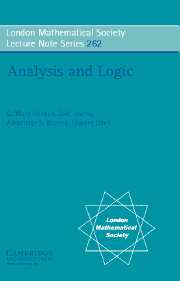Introduction
Published online by Cambridge University Press: 05 May 2013
Summary
The articles in this book had their origins in three mini-courses offered at the conference “Analyse & Logique” held August 25–29, 1997, at the University of Mons-Hainaut in Möns, Belgium. For a long time there have been rich connections between analysis and logic; these articles bear witness that this relationship is still very active, and continues to be important for both areas.
Here we briefly describe these three articles; each one has a more detailed Introduction as its first chapter.
Part One: Ultraproducts in Analysis by C. Ward Henson and Jose Iovino
Applications of model theory in functional analysis have been pursued since the mid 1960s, beginning with the introduction of Banach space ultraproducts by Bretagnolle, Dacunha-Castelle, and Krivine, and of nonstandard hulls by Luxemburg. These constructions have been widely and successfully used in many parts of analysis. This paper presents the basic aspects of a systematic model theoretic framework within which these tools are naturally situated.
The logic developed here has its origin in the question: "what does a normed space structure have in common with its Banach space ultrapowers?" To give a precise answer it is necessary to introduce a suitable formal language of positive bounded formulas together with a semantics of approximate satisfaction. The resulting theory is developed here for a very general class of structures based on normed spaces; our treatment has the most general context possible within functional analysis in which the Banach space ultraproduct and nonstandard hull constructions apply.
- Type
- Chapter
- Information
- Analysis and Logic , pp. xi - xivPublisher: Cambridge University PressPrint publication year: 2003



